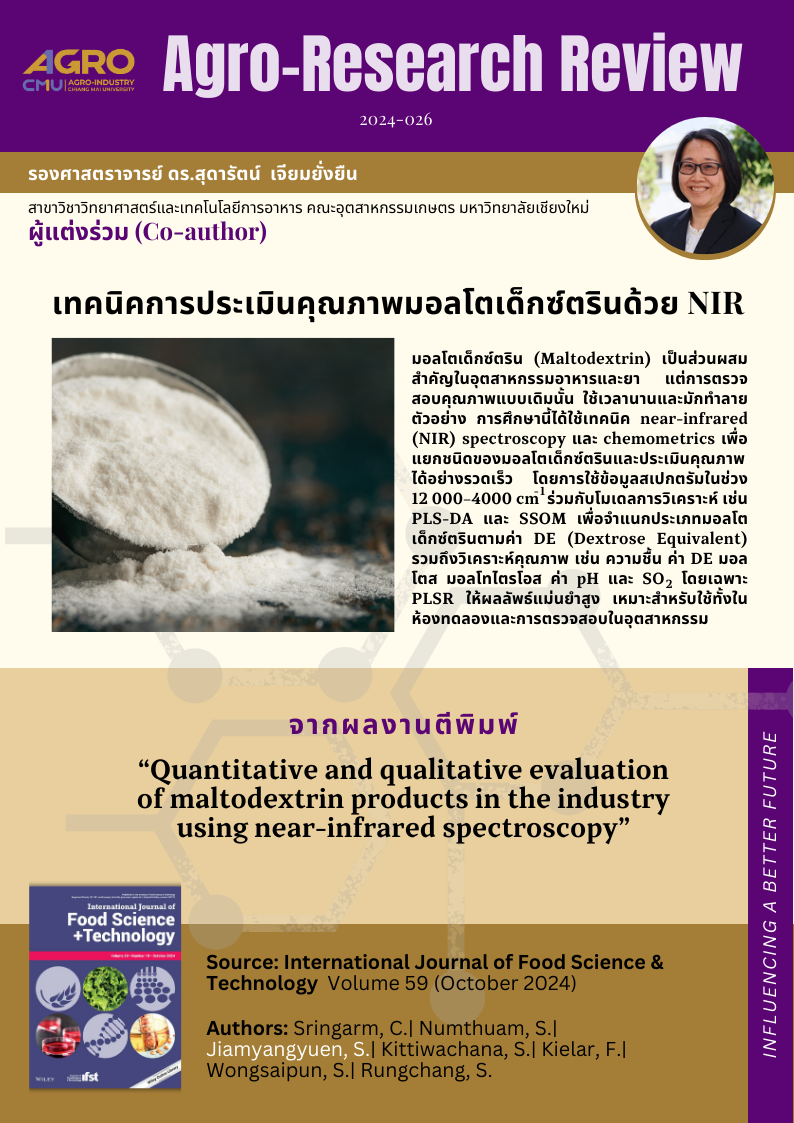
แนะนำงานวิจัย 2024-026 เทคนิคการประเมินคุณภาพมอลโตเด็กซ์ตรินด้วย NIR
มอลโตเด็กซ์ตริน (Maltodextrin) เป็นส่วนผสมสำคัญในอุตสาหกรรมอาหารและยา แต่การตรวจสอบคุณภาพแบบเดิมนั้นใช้เวลานานและมักทำลายตัวอย่าง การศึกษานี้ใช้เทคนิค near-infrared (NIR) spectroscopy และ chemometrics เพื่อแยกชนิดของมอลโตเด็กซ์ตรินและประเมินคุณภาพได้อย่างรวดเร็ว โดยใช้ข้อมูลสเปกตรัมในช่วง 12 000–4000 cm−1 และโมเดลการวิเคราะห์ เช่น PLS-DA และ SSOM เพื่อจำแนกประเภทมอลโตเด็กซ์ตรินตามค่า DE (Dextrose Equivalent) รวมถึงวิเคราะห์คุณภาพ เช่น ความชื้น ค่า DE มอลโตส มอลโทไตรโอส ค่า pH และ SO2 โดยเฉพาะ PLSR ให้ผลลัพธ์แม่นยำสูง เหมาะสำหรับใช้ทั้งในห้องทดลองและการตรวจสอบในอุตสาหกรรม
Maltodextrin is a key ingredient in the food and pharmaceutical industries, but traditional quality control methods are time-consuming and often destructive to samples. This study utilizes near-infrared (NIR) spectroscopy and chemometrics to classify types of maltodextrin and evaluate their quality rapidly. Spectral data in the range of 12 000–4000 cm−1 were analyzed using models such as PLS-DA and SSOM to classify maltodextrin based on their DE (Dextrose Equivalent) values. Additionally, quality parameters such as moisture content, DE value, maltose, maltotriose, pH, and SO2 were analyzed. Particularly, PLSR demonstrated high accuracy, making it suitable for both laboratory and industrial quality control applications.
Topic: Quantitative and qualitative evaluation of maltodextrin products in the industry using near-infrared spectroscopy
Authors: Sringarm, C.| Numthuam, S.| Jiamyangyuen, S.| Kittiwachana, S.| Kielar, F.| Wongsaipun, S.| Rungchang, S.
Abstract:
Maltodextrin is a crucial ingredient in food and pharmaceutical sectors. Traditional quality assessment methods for maltodextrin are destructive and time consuming. This study aimed to employ near-infrared (NIR) spectroscopy and chemometrics to differentiate maltodextrin variants and measure their quality parameters efficiently. NIR spectra were recorded in the range of 12 000–4000 cm−1 using the transflectance mode. The classification model effectively distinguished maltodextrin types based on their dextrose equivalent (DE) values using techniques such as partial least squares-discriminant analysis and supervised self-organising map (SSOM). Moreover, quality parameters including moisture content, DE value, maltose, maltotriose, pH, and SO2 were quantitatively assessed using partial least squares regression (PLSR) and SSOM models. Particularly, PLSR provided better results, with residual predictive deviation values exceeding 2.5 for moisture content, DE values, maltose, and maltotriose. These models can be applied for use in both laboratory settings and industrial monitoring.
Keywords: Calibration; chemometrics; classification; dextrose equivalent; maltodextrin; NIR spectroscopy; quality parameters
View at publisher: https://ifst.onlinelibrary.wiley.com/doi/10.1111/ijfs.17476
#อกมช. #agrocmu #CMU






